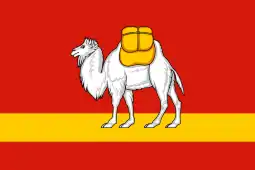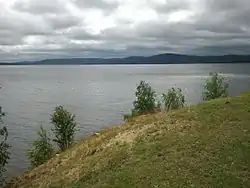Chelyabinsk Oblast
Chelyabinsk Oblast (Russian: Челя́бинская о́бласть, Chelyabinskaya oblast) is a federal subject (an oblast) of Russia in the Ural Mountains region, on the border of Europe and Asia.[11][12][13][14] Its administrative center is the city of Chelyabinsk. Its population is 3,476,217. (2010 Census).[7]
Chelyabinsk Oblast | |
|---|---|
| Челябинская область | |
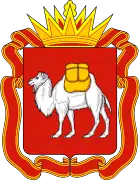 Coat of arms | |
| Anthem: Anthem of Chelyabinsk Oblast | |
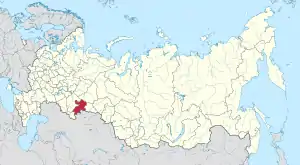 | |
| Coordinates: 54°32′N 60°20′E | |
| Country | Russia |
| Federal district | Urals[1] |
| Economic region | Urals[2] |
| Established | January 17, 1934 |
| Administrative center | Chelyabinsk |
| Government | |
| • Body | Legislative Assembly[3] |
| • Governor[4] | Alexey Texler[5] |
| Area | |
| • Total | 87,900 km2 (33,900 sq mi) |
| Area rank | 36th |
| Population (2010 Census)[7] | |
| • Total | 3,476,217 |
| • Estimate (2018)[8] | 3,493,036 (+0.5%) |
| • Rank | 9th |
| • Density | 40/km2 (100/sq mi) |
| • Urban | 82.0% |
| • Rural | 18.0% |
| Time zone | UTC+5 (MSK+2 |
| ISO 3166 code | RU-CHE |
| License plates | 74, 174, 774 |
| OKTMO ID | 75000000 |
| Official languages | Russian[10] |
| Website | http://www.pravmin74.ru |
History
During the Middle Ages, Bashkir tribes inhabited the Southern Urals; they formed part of the Golden Horde, Nogai Horde, and smaller Bashkir unions. The Tsardom of Russia incorporated the area in the late 16th century. However, Russian colonization of the region only began in the 18th century, with the establishment of a system of fortresses and trade posts on the then-Russian border by the Orenburg Expedition in 1734. Many cities of Chelyabinsk Oblast, including the city of Chelyabinsk itself, trace their history back to those forts.
In 1743 the Chelyabinsk fortress became a center of the Iset Province, a constituent part of the Orenburg Governorate (a direct successor of the Orenburg Expedition). The period from the 1750s to the 1770s saw the emergence of industrial enterprises in the Southern Urals when the first factory-centered towns like Miass, Kyshtym, and Zlatoust were founded. After the Southern Urals recovered from the Pugachev's Rebellion of 1773–1775, the territory of modern-day Chelyabinsk Oblast started to attract more people from the European part of Russia. By the mid-19th century Chelyabinsk was a major trade center in the Urals, and after the construction of the Trans-Siberian Railway in the 1890s it became an important transport hub that connected Siberia to the rest of the Russian Empire.
In 1919 Chelyabinsk became the regional capital of the newly formed Chelyabinsk Governorate of the Russian SFSR, which combined eastern portions of the Orenburg Governorate with Kurgan of the Tobolsk Governorate. At this time, the population of the new region already exceeded one million people. In 1923, together with the Perm, Yekaterinburg Governorate and Tyumen governorates, it merged into a single Ural Oblast that lasted only ten years, until 1934. On January 17, 1934, Chelyabinsk Oblast was finally established. Its current boundaries were formed when Kurgan Oblast was detached from it in 1943.
Soviet industrialization
During the 1930s the regional economy and industrial output grew as Chelyabinsk Oblast became a key focus of the First Five-Year Plan. Key factories and enterprises that formed the core of the modern Chelyabinsk economy, including the Magnitogorsk Iron and Steel Works, the Chelyabinsk Tractor Plant and the Chelyabinsk Metallurgical Plant, originated at this time. The economy continued to grow after the outbreak of the Great Patriotic War in 1941, as industries evacuated from the western parts of the Soviet Union to the Urals, and to Chelyabinsk Oblast in particular. During the war, Magnitogorsk alone produced one third of all Soviet steel, while the city of Chelyabinsk became the main center of Soviet tank production, earning the nickname "Tankograd" (Tank City).
Nuclear research
Chelyabinsk Oblast has been associated with top-secret nuclear research since the 1940s. While there are no nuclear power stations in Chelyabinsk, a number of production reactors were located there starting with the early Cold War. A serious nuclear accident occurred in 1957 at the Mayak nuclear fuel reprocessing plant, 150 km north-west of the city, which led to evacuations and fatalities throughout the oblast, although not in Chelyabinsk city. The province was closed to all foreigners until 1992, with the sole exception of allowing a British medical team in following a two-train rail explosion in the mid-1980s.
Slawomir Grunberg has made the documentary Chelyabinsk: The Most Contaminated Spot on the Planet (1994) about the unsafe dumping of radioactive waste in the Techa River and in Lake Karachay.
Recent history
On 4 July 1997, Chelyabinsk, alongside Bryansk, Magadan, Saratov, and Vologda signed a power-sharing agreement with the government of Russia, granting it autonomy.[15] The agreement would be abolished on 2 February 2002.[16]
On February 15, 2013, a 10,000 ton meteoroid entered the Earth's atmosphere over Russia at about 09:20 YEKT (03:20 UTC). It passed over the southern Ural region and exploded in an air burst over Chelyabinsk Oblast. About 1,500 people were reported injured, including 311 children. Health officials said 112 people had been hospitalized, mainly from injuries caused by glass from windows shattered by a shock wave; two were reported to be in serious condition. As many as 3,000 buildings in six cities across the region were damaged by the explosion and impacts. The meteor created a dazzling light as it air burst, bright enough to cast shadows during broad daylight in Chelyabinsk.
Economy
The largest companies in the region include Magnitogorsk Iron and Steel Works, Chelyabinsk Metallurgical Plant (Mechel group), Chelyabinsk Pipe Rolling Plant, Chelyabinsk Electrometallurgical Plant, Chelyabinsk Zinc Plant, Ashinsky Metallurgical Plant.[17]
Geography
Chelyabinsk Oblast is on the eastern slope of the Southern Urals. Only a small part of the territory to the west is on the western slopes of the Southern Urals.
Chelyabinsk Oblast is situated in the Southern Urals, near Kurgan and Sverdlovsk oblast. Most of the Oblast is located to the east of the Ural Mountains, which form the continental boundary between Europe and Asia. This boundary is marked by a stone pillar at the Uraltau pass near the Urzhumka station (8 km from Zlatoust), which has "Europe" written on one side and "Asia" on the other. In Chelyabinsk Oblast, Zlatoust city, Katav-Ivanovsk, and Satka are located in Europe, while Chelyabinsk, Troitsk, and Miass are in Asia. Magnitogorsk is located on both continents.[18]
The area of Chelyabinsk Oblast is 88,900 km2.[19] The total length of its external border is 2750 km, and the Oblast measures 400 km from north to south and 490 km from west to east.
Relief
Chelyabinsk Oblast has a very diverse landscape, ranging from lowlands and hilly plains to mountain ranges with peaks exceeding 1,000 m, including Nurgush mountain (1406 m). The mountainous area has several ski resorts.
The West Siberian Plain is bounded on the west horizontal (elevation 190 m above sea level), which passes through the village of Bagaryak, Kunashak and continues through Chelyabinsk to the south. The lowlands are located in the northeast, and the elevation drops to 130 m in the eastern border region.
Hydrology
Numerous rivers originate within the region, within the basins of the Kama, Tobol, and Ural rivers. The region is home to 348 rivers longer than 10 km (totaling 10,235 km in length), 17 of which are over 100 km in length. Seven rivers, the Miass, Uy, Ural, Ay, Ufa, Uvelka, and Gumbeyka, pass through the area and are longer than 200 km.
Chelyabinsk Oblast is also home to more than 3,748 lakes, mostly located in the north and east and covering a total area of 2125 km2. Many of the lakes in this area, including Lake Turgoyak, Zyuratkul, and Lake Itkul, are famous for their clear waters and attract tourism. Some of the lakes in the eastern foothills have tectonic origins as water accumulated in tectonic failures (basins), resulting in very deep lakes that can reach 30–40 m.
Politics
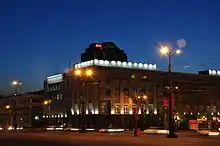
During the Soviet period, the highest authority in the Oblast was shared between three positions: the First Secretary of the Chelyabinsk CPSU Committee (who held the most power), the Chairman of the Oblast Soviet (legislative power), and the Chairman of the Oblast Executive Committee (executive power). Since the dissolution of the Soviet Union in 1991, the CPSU lost its monopoly on power.
Today, the Charter of Chelyabinsk Oblast governs the political structure of the region. The Legislative Assembly of Chelyabinsk Oblast serves as the province's regional parliament and exercises legislative authority, with the power to pass laws, resolutions, and other legal acts and oversee their implementation and observance. The Oblast Government, led by the Governor, is the highest executive body in the region, and includes territorial executive bodies such as district administrations, committees, and commissions that facilitate development and run the day-to-day matters of the province.
Administrative divisions
Demographics
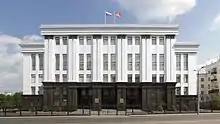
Population: 3,476,217 (2010 Census);[7] 3,603,339 (2002 Census);[20] 3,623,732 (1989 Census).[21]
Sights
Taganay National Park
Taganay National Park is located northeast of the city of Zlatoust, Chelyabinsk Oblast. Taganay National Park, famous for its beauty, is one of the most popular among tourists in the Urals. There are many interesting places in the national park. Tourists can see here huge mountain ranges, alpine meadows, bizarre stone outcrops and an amazing stone river stretching for several kilometers, relict forests, woodlands and mountain tundra, ancient mineral mines and mountain rivers flowing both to Europe and Asia. Taganay National Park is one of the most comfortable and hospitable parks in the Urals. Taganay National Park was established on March 5, 1991. It became the first in the Urals.
Gagarin Park
After a spurt of industrial growth in 1930s, Chelyabinsk saw more industrialization when Stalin moved parts of the Soviet production factory to the city during WWII. Chelyabinsk's industrial past is evident even today in the busy city. However, the many parks and green spaces across the city stand in stark contrast. Among these parks, the most famous one is Gagarin Central Park. It is a large recreational space located in the heart of the city. The park gets its name from Yuri Gagarin, a Soviet cosmonaut and the first person to enter space.
An urban retreat
The 12-hectare park is a vibrant space full of forest walks, lakes, and a combination of rugged, natural grounds and landscaped gardens. As you enter the main park gates, you are greeted by an avenue which runs the length of the park through the center. Residents enjoy this city retreat on a daily basis whether it is for strolling through the park, jogging, biking, roller blading, or even horse riding. It is the ideal place to lay down your blanket and enjoy a family picnic.
More than just a park
The park's boating pond is also a great place to feed the ducks. On one side of the park is Shershnevskoe water reservoir, a favorite among bathers in the summer. In winter, part of the park is transformed into a winter paradise frequented by skiers. There is a summer stage for holding various events, and a show ground with rides and amusements for those who are brave enough. Surrounding the park are other recreational facilities including the Traktor Ice Hockey Stadium and the Central Football Stadium. You will find the city zoo on the edge of Gagarin, a great attraction for children. Small reminders of the city's industrial past can be seen even within the park boundaries, such as several quarries that were primarily used to extract granite.
Monuments
There are lots of monuments, memorials, and sculptures in Chelyabinsk. For example, the monument to Igor Kurchatov, the academician-nuclear scientist, was opened in 1986 to the 250th anniversary of Chelyabinsk, the Monument to the Professional Beggar and Sculpture to fashionable girl in front of the mirror in Kirovka, Monument to Orlenok (monument on the Aloe polye in Chelyabinsk, opened on October 29, 1958 on the day of the fortieth anniversary of the Komsomol), Sculpture of The Postman, Memorial to Law and Order Soldiers, Monument to Soldiers-Internationalists, Sculpture the Firefighter. Many of these monuments, memorials, and sculptures are in Kirovka street, the pedestrian street in the center of Chelyabinsk. The official name of the pedestrian part of the street - "Kirovka" was given by the order of the head of the city on September 13, 2004 after a competition held in May 2004.
Settlements
Chelyabinsk Oblast is highly urbanized.
According to the 2010 Census, the Oblast's ethnic composition was:[7]
- 2,829,899 Russians (83.8%);
- 180,913 Tatars (5.4%);
- 162,513 Bashkirs (4.8%);
- 50,081 Ukrainians (1.5%);
- 35,297 Kazakhs (1.05%);
- 18,687 Germans (0.5%);
- 13,035 Belarusians (0.4%);
- 12,147 Mordvins (0.2%);
- 9,311 Armenians (0.3%);
- 65,190 others (1.6);
- 99,144 people were registered from administrative databases, and could not declare an ethnicity. It is estimated that the proportion of ethnicities in this group is the same as that of the declared group.[19]
- Births (2011): 47,300 (13.6 per 1000)
- Deaths (2011): 49,469 (14.2 per 1000)[22]
- Vital statistics for 2012[23]
- Births: 49 885 (14.3 per 1000)
- Deaths: 49 367 (14.2 per 1000)
Total fertility rate:[24]
2009 - 1.63 | 2010 - 1.65 | 2011 - 1.70 | 2012 - 1.81 | 2013 - 1.80 | 2014 - 1.86 | 2015 - 1.84 | 2016 - 1.81(e)
Religion
According to a 2012 survey,[25] 30.9% of the population of Chelyabinsk Oblast adheres to the Russian Orthodox Church, 8% are unaffiliated generic Christians, 5% adheres to other Orthodox Churches, 8% of the population is Muslim, 1% adheres to Slavic Rodnovery (Slavic Neopaganism), and 0.4% to forms of Hinduism (Vedism, Krishnaism or Tantrism). In addition, 29% of the population deems itself to be "spiritual but not religious", 14% is atheist, and 4.7% follows other religions or did not give an answer to the question.[25]
Vital statistics for 2008
Source:[27]
| District (2008) | Type | Births | Deaths | NG | BR | DR | NGR |
|---|---|---|---|---|---|---|---|
| Chelyabinsk Oblast | Obl | 44931 | 52625 | -7694 | 12.8 | 15.0 | -0.22% |
| Urban Areas | Obl | 34550 | 41787 | -7237 | 12.1 | 14.6 | -0.25% |
| Rural Areas | Obl | 10381 | 10838 | -457 | 15.9 | 16.6 | -0.07% |
| Chelyabinsk | Urb | 12540 | 14192 | -1652 | 11.5 | 13.0 | -0.15% |
| Verkhny Ufaley | Urb | 516 | 727 | -211 | 13.6 | 19.1 | -0.55% |
| Zlatoust | Urb | 2111 | 2658 | -547 | 11.1 | 13.9 | -0.28% |
| Karabash | Urb | 227 | 262 | -35 | 14.5 | 16.7 | -0.22% |
| Kopeysk | Urb | 1737 | 2476 | -739 | 12.5 | 17.8 | -0.53% |
| Kyshtym | Urb | 535 | 695 | -160 | 12.5 | 16.2 | -0.37% |
| Lokomotivny | Urb | 117 | 41 | 76 | 11.8 | 4.1 | 0.77% |
| Magnitogorsk | Urb | 5276 | 6112 | -836 | 12.9 | 14.9 | -0.20% |
| Miass | Urb | 2289 | 2559 | -270 | 13.7 | 15.3 | -0.16% |
| Ozyorsk | Urb | 912 | 1312 | -400 | 9.2 | 13.2 | -0.40% |
| Snezhinsk | Urb | 544 | 586 | -42 | 10.8 | 11.6 | -0.08% |
| Tryokhgorny | Urb | 402 | 338 | 64 | 11.7 | 9.8 | 0.19% |
| Troitsk | Urb | 1085 | 1269 | -184 | 13.2 | 15.4 | -0.22% |
| Ust-Katav | Urb | 318 | 515 | -197 | 11.3 | 18.2 | -0.69% |
| Chebarkul | Urb | 550 | 698 | -148 | 12.7 | 16.2 | -0.35% |
| Yuzhnouralsk | Urb | 428 | 602 | -174 | 11.1 | 15.6 | -0.45% |
| Agapovsky | Rur | 649 | 513 | 136 | 18.5 | 14.6 | 0.39% |
| Argayashsky | Rur | 831 | 671 | 160 | 19.7 | 15.9 | 0.38% |
| Ashinsky | Rur | 831 | 1286 | -455 | 12.6 | 19.5 | -0.69% |
| Bredinsky | Rur | 485 | 480 | 5 | 15.6 | 15.4 | 0.02% |
| Varnensky | Rur | 460 | 453 | 7 | 15.9 | 15.7 | 0.02% |
| Verkhneuralsky | Rur | 575 | 743 | -168 | 13.6 | 17.6 | -0.40% |
| Yemanzhelinsky | Rur | 648 | 923 | -275 | 12.2 | 17.3 | -0.51% |
| Yetkulsky | Rur | 443 | 466 | -23 | 14.7 | 15.5 | -0.08% |
| Kartalinsky | Rur | 702 | 809 | -107 | 14.1 | 16.2 | -0.21% |
| Kaslinsky | Rur | 461 | 758 | -297 | 12.0 | 19.7 | -0.77% |
| Katav-Ivanovsky | Rur | 448 | 709 | -261 | 12.8 | 20.2 | -0.74% |
| Kizilsky | Rur | 432 | 400 | 32 | 16.2 | 15.0 | 0.12% |
| Korkinsky | Rur | 900 | 1256 | -356 | 13.8 | 19.3 | -0.55% |
| Krasnoarmeysky | Rur | 638 | 754 | -116 | 14.6 | 17.3 | -0.27% |
| Kunashaksky | Rur | 521 | 549 | -28 | 17.6 | 18.6 | -0.10% |
| Kusinsk | Rur | 420 | 535 | -115 | 13.9 | 17.7 | -0.38% |
| Nagaybaksky | Rur | 334 | 392 | -58 | 15.0 | 17.7 | -0.27% |
| Nyazepetrovsky | Rur | 298 | 433 | -135 | 14.6 | 21.3 | -0.67% |
| Oktyabrsky | Rur | 419 | 398 | 21 | 15.6 | 14.8 | 0.08% |
| Plastovsky | Rur | 450 | 453 | -3 | 17.2 | 17.3 | -0.01% |
| Satkinsky | Rur | 1230 | 1398 | -168 | 14.2 | 16.1 | -0.19% |
| Sosnovsky | Rur | 942 | 933 | 9 | 16.0 | 15.8 | 0.02% |
| Troitsky | Rur | 529 | 506 | 23 | 17.1 | 16.3 | 0.08% |
| Uvelsky | Rur | 508 | 533 | -25 | 16.1 | 16.9 | -0.08% |
| Uysky | Rur | 385 | 387 | -2 | 14.6 | 14.7 | -0.01% |
| Chebarkulsky | Rur | 494 | 538 | -44 | 16.6 | 18.1 | -0.15% |
| Chesmensky | Rur | 311 | 307 | 4 | 15.5 | 15.3 | 0.02% |
References
- Президент Российской Федерации. Указ №849 от 13 мая 2000 г. «О полномочном представителе Президента Российской Федерации в федеральном округе». Вступил в силу 13 мая 2000 г. Опубликован: "Собрание законодательства РФ", No. 20, ст. 2112, 15 мая 2000 г. (President of the Russian Federation. Decree #849 of May 13, 2000 On the Plenipotentiary Representative of the President of the Russian Federation in a Federal District. Effective as of May 13, 2000.).
- Госстандарт Российской Федерации. №ОК 024-95 27 декабря 1995 г. «Общероссийский классификатор экономических регионов. 2. Экономические районы», в ред. Изменения №5/2001 ОКЭР. (Gosstandart of the Russian Federation. #OK 024-95 December 27, 1995 Russian Classification of Economic Regions. 2. Economic Regions, as amended by the Amendment #5/2001 OKER. ).
- Charter, Article 8.3-1
- Charter, Article 8.4
- Official website of the Governor of Chelyabinsk Oblast. Boris Alexandrovich Dubrovsky Archived 2014-07-07 at the Wayback Machine, Acting Governor of Chelyabinsk Oblast
- Федеральная служба государственной статистики (Federal State Statistics Service) (2004-05-21). "Территория, число районов, населённых пунктов и сельских администраций по субъектам Российской Федерации (Territory, Number of Districts, Inhabited Localities, and Rural Administration by Federal Subjects of the Russian Federation)". Всероссийская перепись населения 2002 года (All-Russia Population Census of 2002) (in Russian). Federal State Statistics Service. Retrieved 2011-11-01.
- Russian Federal State Statistics Service (2011). "Всероссийская перепись населения 2010 года. Том 1" [2010 All-Russian Population Census, vol. 1]. Всероссийская перепись населения 2010 года [2010 All-Russia Population Census] (in Russian). Federal State Statistics Service.
- "26. Численность постоянного населения Российской Федерации по муниципальным образованиям на 1 января 2018 года". Federal State Statistics Service. Retrieved 23 January 2019.
- "Об исчислении времени". Официальный интернет-портал правовой информации (in Russian). 3 June 2011. Retrieved 19 January 2019.
- Official throughout the Russian Federation according to Article 68.1 of the Constitution of Russia.
- "Investing in Chelyabinsk city - Invest in Russia". Unvestunrussia.biz. Retrieved June 9, 2016.
- "On cooperation between the Chelyabinsk region and Japan" (PDF). Rotobo.or.jp. Retrieved June 9, 2016.
- "Invest in Ural". Investunural.com. Archived from the original on 2013-02-24. Retrieved June 9, 2016.
- "Guide to Investment : Chelyabinsk Region" (PDF). Econom-chelrug.ru. Archived from the original (PDF) on 2016-03-06. Retrieved June 9, 2016.
- "Moscow Signs Power-Sharing Agreements With Five More Regions". Jamestown. 1997-07-07. Retrieved 2019-05-02.
- Chuman, Mizuki. "The Rise and Fall of Power-Sharing Treaties Between Center and Regions in Post-Soviet Russia" (PDF). Demokratizatsiya: 146. Archived from the original (PDF) on 2019-03-08. Retrieved 2019-05-02.
- "Выписки ЕГРЮЛ и ЕГРИП, проверка контрагентов, ИНН и КПП организаций, реквизиты ИП и ООО". СБИС (in Russian). Retrieved 20 October 2018.
- "Magnitogorsk - is our city in the Urals". City of Magnitogorsk. August 24, 2012. Retrieved June 12, 2016.
- "ВПН-2010". Perepis-2010.ru. Retrieved June 9, 2016.
- Russian Federal State Statistics Service (21 May 2004). "Численность населения России, субъектов Российской Федерации в составе федеральных округов, районов, городских поселений, сельских населённых пунктов – районных центров и сельских населённых пунктов с населением 3 тысячи и более человек" [Population of Russia, Its Federal Districts, Federal Subjects, Districts, Urban Localities, Rural Localities—Administrative Centers, and Rural Localities with Population of Over 3,000] (XLS). Всероссийская перепись населения 2002 года [All-Russia Population Census of 2002] (in Russian).
- "Всесоюзная перепись населения 1989 г. Численность наличного населения союзных и автономных республик, автономных областей и округов, краёв, областей, районов, городских поселений и сёл-райцентров" [All Union Population Census of 1989: Present Population of Union and Autonomous Republics, Autonomous Oblasts and Okrugs, Krais, Oblasts, Districts, Urban Settlements, and Villages Serving as District Administrative Centers]. Всесоюзная перепись населения 1989 года [All-Union Population Census of 1989] (in Russian). Институт демографии Национального исследовательского университета: Высшая школа экономики [Institute of Demography at the National Research University: Higher School of Economics]. 1989 – via Demoscope Weekly.
- "Естественное движение населения в разрезе субъектов Российской Федерации". Gks.ru. Retrieved June 9, 2016.
- "Каталог публикаций::Федеральная служба государственной статистики". Gks.ru. Retrieved June 9, 2016.
- "Arena: Atlas of Religions and Nationalities in Russia". Sreda, 2012.
- 2012 Arena Atlas Religion Maps. "Ogonek", № 34 (5243), 27/08/2012. Retrieved 21/04/2017. Archived.
Sources
- Законодательное Собрание Челябинской области. Закон №22-ЗО от 25 мая 2006 г. «Устав (основной закон) Челябинской области», в ред. Закона №427-ЗО от 30 апреля 2009 г. (Legislative Assembly of Chelyabinsk Oblast. Law #22-ZO of May 25, 2006 Charter (Basic Law) of Chelyabinsk Oblast, as amended by the Law #427-ZO of April 30, 2009. ).
External links
| Wikimedia Commons has media related to Chelyabinsk Oblast. |
